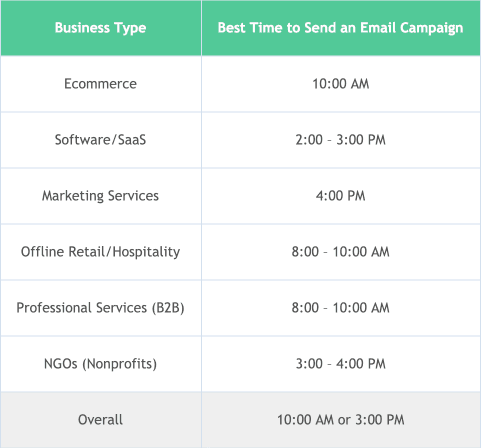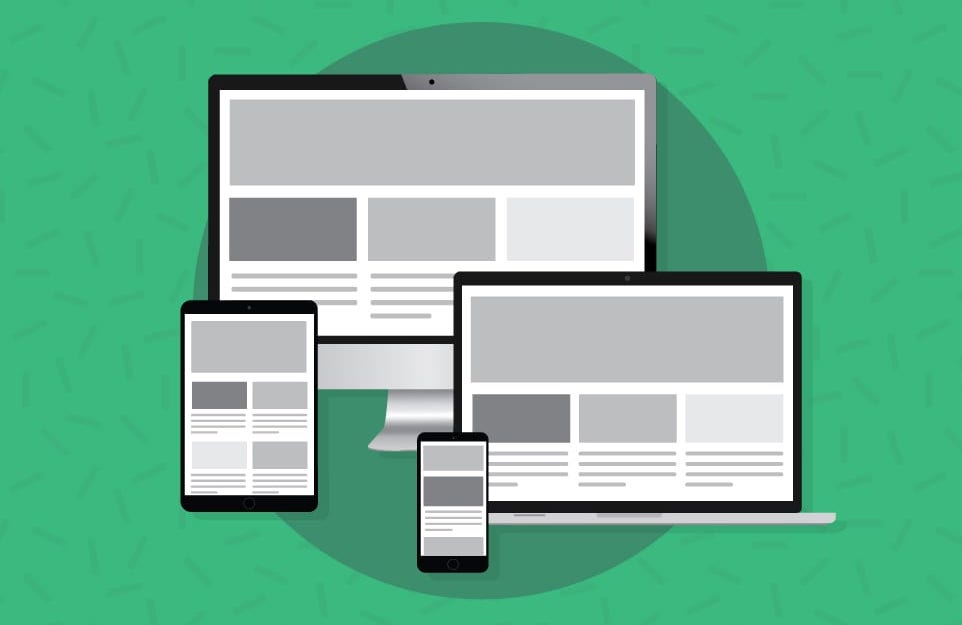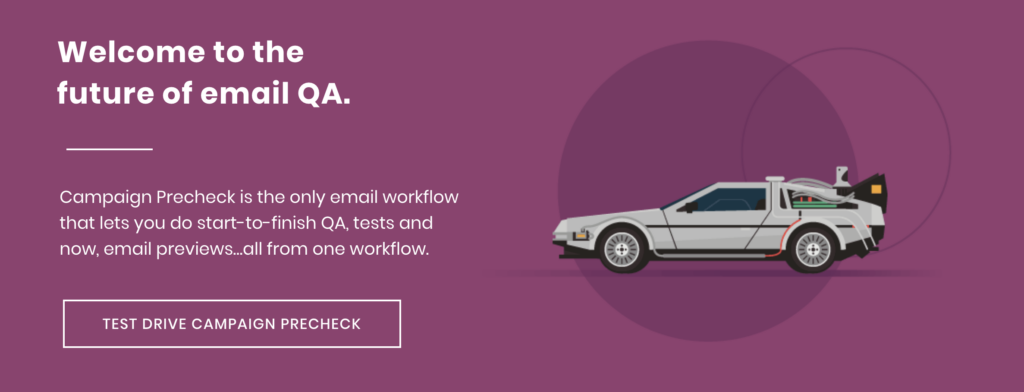Email Marketing
Don’t Be Fooled by These 8 Email Marketing Myths

Email Marketing

This post was updated on November 20, 2019. It was originally published in June 2014.
In an industry that is constantly evolving, it is critical to stay on top of the most up-to-date marketing research and practices. However, with a new blog being published every half second, it’s hard to sift through every article to find out which posts are facts, and which are fiction. That’s why we decided to uncover eight email marketing myths circulating around the web and prove why they should not be hailed as fact. Have you been too afraid to use the word “free” in your subject line? Do you stress over the length of your emails? Don’t let these email marketing myths keep you up at night.
Many people are sending their campaigns in the morning under the assumption that the early bird gets the worm. However, Mailchimp uncovered some amazing data when they analyzed more than a billion emails regarding send time for marketing messages. The chart below indicates that recipients are more likely to open their email after 12 p.m.
This is a screen capture from Mailchimp when they tested the optimal time to send an email. The chart also reveals that the hours between 2-5 p.m. are the most active hours of email opens by time of day. However, the best time to send an email does not remain static. There are many contradictory findings of when is best to send. For example, Experian researchers found that sending emails between 4 and 8 a.m. has the highest response rates in all areas, but Mailchimp found the best email open rate to be 10 a.m. local time for recipients. The reason these stats continue to change is because every audience is different. That is why marketers should use industry standards as a starting point, THEN experiment with send times for their particular audience. Check out this chart by Convertful breaking down the optimal send times by industry:

As you can see, a send time early in the morning is not always the most effective option. Now that you have a jumping off point for when to send to your industry, start A/B testing for your specific audience!
Another prominent member of the email marketing myths family is that if you send frequently to your email list, then you’ll irritate them, or even worse… get marked as spam. Your parents were right when they warned you not to believe everything you hear. Alchemy Worx released a case study that analyzed Aviva Insurance’s email frequency and they found some real marketing gems. In their study, they discovered that when Aviva’s email sends increased from one annual renewal email to monthly sends and even multiple monthly sends to certain segments, it quadrupled both their unique clicks and total clicks. That increase in email sending frequency also resulted in a 48% increase in prospects requesting quotes and improved their email revenue by 45%. However, the most important caveat this study calls out is that increasing your send frequency must also accompany an increase in value.
Again: Increasing your send frequency must also accompany an increase in value.
If you’re not sure what your email list will find valuable, you can conduct surveys to find out what subscribers want to see from you. From there, create a strategy and slowly start sending more emails.
Alchemy Worx set the record straight regarding this notion when they reported that less than 1 subscriber in every 2,000 will mark an email as spam. It is safe to say that with a 1:2,000 ratio, the odds are in your favor. It is important to note, a large number of internet service providers (ISPs) like Gmail and Yahoo use the sender’s engagement metrics, such as open and click-through rates, to determine if an email should be sent to the inbox or spam. From Alchemy Worx’s findings above, sending more frequently can drastically incrase email open rates.
So, if you follow Alchemy’s advice and someone does mark you as spam (it happens to the best of us), a higher sending frequency that equates to higher engagement metrics will protect your sender reputation from a single complaint. ISPs like Google will be able to see that you have accrued a good sender reputation from engagement metrics and therefore you’ll be less susceptible to ending up on a blocklist. Win/win! A higher sending frequency will not weaken the impact of your email efforts.
Rather, it will strengthen it through fewer unsubscribes, higher open rates and an increase in revenue. While there isn’t a perfect or magical number of emails you should send each week or month to your list, try to find the “Goldilocks zone”: the sending pattern that is just right for your audience. Preference centers are also a great way to let subscribers self-segment themselves so they tell you how often to message them.
If you aren’t taking advantage of responsive email design right now, you are flushing money down the drain. According to EmailMonday, 75% of consumers use their smartphone for reading email. On top of that, Chamaileon reports that up to 80% of users delete emails they can’t read (e.g.: non-responsive emails that look junky on mobile).
Still not convinced? How about a case study to sway you? Stream Companies, a fully integrated advertising agency, utilized our state-of-the-art analytics within their email marketing campaigns. Stream found that 41% of one of their client’s subscribers were opening emails on mobile devices. So, they updated their client’s pre-existing templates to make them responsive.
To find out how to add responsive design to your emails, check out how to target mobile devices with media queries.

To ensure their template revamp was effective, they ran three 50/50 split tests over a month where the system randomly selected 50% of the list to get the new responsive template and for 50% of the list to get the non-responsive template. Every other element of the two emails being tested were identical (i.e. from name, from address, promotional content and subject lines), the only change was that one email was mobile-friendly and the other was not. The responsive email reigned victorious over the original design. Below are the results: First test:
Second test:
Third test:
All the stats above speak to the fact that responsive design is no longer a luxury for email marketers, but instead, a necessity.
Spam filters have become much more refined and complex when identifying which emails are from legitimate senders or not. They look at a long list of criteria to decide whether your email is junk. What you think may be interpreted as “spammy content” by a spam filter (ex: using the word “free” in the subject line) will rarely be the single culprit that sends your email to the junk folder. Here are some email elements that a spam filter will check:
Alchemy Worx analyzed the effect of spammy subject lines on their own inbox placement in an attempt to see if keywords affect deliverability.
They found that the words and phrases often thought to ensure an email ends up in the junk folder actually have little or no effect. This was also seen by Mailchimp and Hubspot as well when they both found that using words like “free” in your subject line has no effect on your deliverability. It is also important to keep in mind that the list of what qualifies as “spammy” changes often, because the filters adapt based on what subscribers mark as spam in their inboxes.
However, spam filters are still a very mystifying beast. Even if you follow all the rules, you can get flagged and find yourself wondering how. The time to find out about a spam problem is before your email send, not after. We can help! Diagnose and solve deliverability issues with our pre-deployment spam testing across the most popular spam filters.
We will help you identify which filters are blocking your emails and provide as much detail as we can squeeze out of them to help troubleshoot.
Here’s the thing: up to 60% of customers disable images. If that’s not enough, most email clients block images by default. If you leverage splicing, or heavily-designed emails, your subscribers might be missing your primary call-to-action (CTA) if they don’t ‘click to download’ your images.
That said, plain text emails actually have the potential to resonate with far more subscribers on your email list. This is another instance where having detailed insights of the email clients and devices your readers are on can be helpful in your design strategy. To figure out what rings true for your brand, you can A/B test a heavily-designed vs. plain text email several times so you can conclusively know which performs better. Also know that it doesn’t have to be one or the other.
Having a healthy mix of text and images in email is a happy medium when you’re trying to resonate with the highest possible number of subscribers in a given segment.
Related: Tips for Email Design Best Practices
In terms of email marketing myths, the particular one should never have entered the millennium. Tone is not what you say in an email, but how you say it.
Executing your tone successfully is what stands between decent copy and great copy. Tone can evoke an emotional response in readers. This is important because emotion is a key factor when a reader considers whether or not to engage or make a purchase. Strictly professional tones can come off dry and formal, failing to resonate with your audience. That is why you may want to consider adding your own brand’s personality into your copy. We’ve seen firsthand some. pretty. awesome. emails. from brands who have leaned into their true voices.
One way you can do this is by making your copy conversational in nature. Speak to people in an email the way you speak to them in real life. Loosen up a little in your copy so you don’t sound like a robot. You can do this through colloquial writing by using more informal language, or even slang! One example of this can be seen as you navigate to our website. Check it out below:

We could have taken a more formal approach and said “Optimize your workflow for peak efficiency,” but that just doesn’t have the same ring to it.
We decided that our tone should mirror how we talk by keeping conversational with, “welcome to the future”. Heck, if it’s appropriate, you can even throw in riskier words like ‘crap’ or ‘damn’ to make your point. Keep in mind, though, everything in moderation. You want to grab someone’s attention and make your text feel more honest, but stay away from shock tactics like dropping an F-bomb or potentially offending your readers.
Don’t get me wrong, there is a time and a place for both short and long email copy. The trick is knowing when each method is appropriate. One of the key things to remember when writing your email is that you only need to write as much as you need to make a persuasive presentation.
Sometimes, it takes more copy to fully persuade your readers and assuage their hesitations. Of course, this is also going to differ between brands and their audiences. Email on Acid recently conducted our own A/B test on ideal body copy length. Our email marketer Paul wanted to learn if emails with less than 100 words would earn higher engagement and click-throughs than ones with more than 100 words. As it turns out, our own audience doesn’t have a hard preference one way or the other.
But that’s just our community. Every brand should test this for themselves.
Unsubscribes are going to happen. Period.
While you do not want to see a spike in your unsubscribe rate, you can avoid potential IP reputation disasters and gain insights as to what tactics are or aren’t working. For instance, if you see your unsubscribe rate spike for certain emails, that is a good indicator that those marketing tactics were less than desirable to your audience. If a subscriber decides they don’t want your emails anymore, you’d rather them unsubscribe than mark you as spam, right? An unsubscribe is still a healthy engagement because it’s keeping your subscriber list healthy and keeps any red flags from popping up.
Related: Deliverability FAQs
Make sure your unsubscribe button is loud and proud in your footer.
The more engaged subscribers you have on your list (read: people that ACTUALLY are interested in your offering), the better engagement, open, and click-through rates you will have!
Now you know that not all email marketing maxims hold water.
There’s a lot of data out there, and it can be hard to sift through. Take it all with a grain of salt and don’t rely on anyone else’s data as hard fact for your brand. Always conduct your own A/B tests and experiments so you know you’re being as strategic as possible for your own subscribers, not someone else’s. Before you dive in head first using a marketing tactic you found circulating the web, ensure there’s research to back it up. Marketing is part intuition and part science, so be smart when deciding what email tactics you will use or avoid. Did we miss anything? Share other email marketing myths you’ve found in the comments!